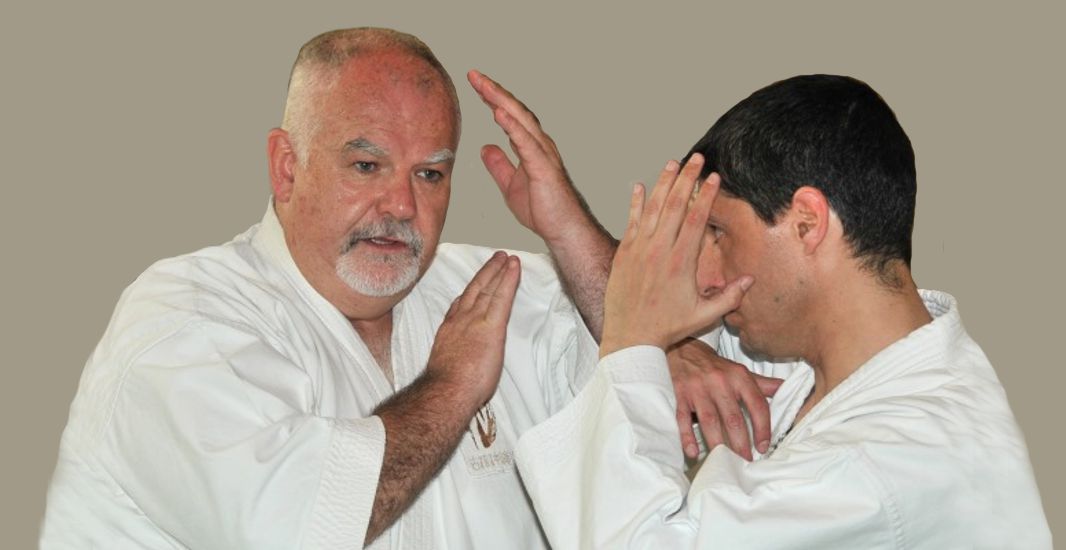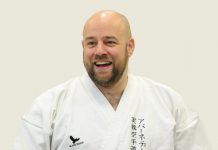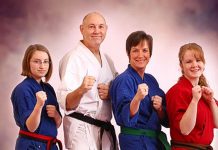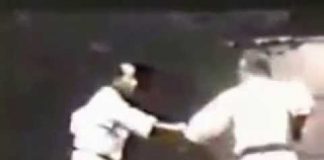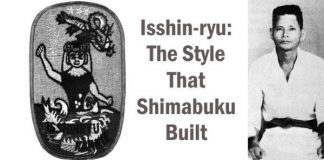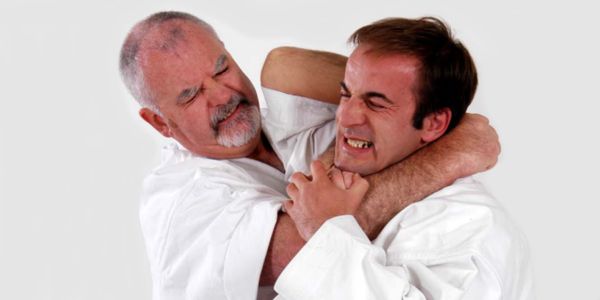
Sometimes you don’t know how to fit in until you break out. Breaking out is necessary to penetrate deeper within.
Introduction
At 54 years old, Patrick McCarthy Hanshi [範士], is a 5th generation learner of Uchinadi1 with an impeccable lineage of Okinawan instructors, starting with his teacher Kinjo Hiroshi2 [金城裕] and his teacher’s teacher, Hanashiro Chomo3 [花城長茂], Itosu Ankoh4 [糸洲 安恒] who preceded him, and his master, Matsumura Sokon5 [松村 宗棍] — historically the tradition’s most visible pioneer. A Canadian-born Australian migrant, McCarthy has studied the fighting arts since childhood and enjoyed a rewarding competitive background6 before embarking upon a lengthy journey to Japan where he ultimately resurfaced as a best-selling author.7 As someone who has made unravelling the mysteries of karate his life’s work8, Patrick McCarthy believes that Tigwa9 evolved as a multi-faceted synthesis of no less than four individual disciplines10, but was ultimately simplified into a more pragmatic discipline of percussive impact to serve as a vehicle promoting physical fitness and social conformity11. Karate has, in many ways, became a microcosm of the austere society12 in which it was forged, particularly due to its transformation into a recreational activity13 during a period of radical military escalation14 and profoundly influenced by Japanese Budo culture15.
Karate flourished as a ritualized and rule-bound practice in pre-war Japan, ascending to the apex of popularity in the University16 environment. Foreign interest in budo17 gradually increased during Japan’s post-war period until it became firmly entrenched in Western culture by the 1960’s. A product of this extended legacy, it was during that period of popularization in the 1960’s that Patrick McCarthy started learning karate18 but after years of study19 he ultimately became dissatisfied with impractical application practices20, and the convoluted21 teaching standards22 of 3K-training.23 In particular, he often found himself questioning the value of teaching learners to respond to reverse punches, back fists and sidekicks when it is clearly not representative of the kind of violent encounters24 the art was originally developed to address. More importantly, if karate was just about punching and kicking25, as is pontificated from the so-called highest sources26, McCarthy wondered why the need for kata27 in the first place. With kata containing a myriad of techniques28, other than just punching and kicking, he couldn’t help but ponder what tactical intentions29 their creators originally set forth30. Challenging the commonly accepted version of its historical evolution, and the pedagogical veracity of this heritage, McCarthy’s audacity provoked anger amidst conservative traditionalists who, unwilling to think-outside-the-box, perceived his questioning of authority as brash and disrespectful. Beyond the expected criticism he attracted from those who strongly favored orthodox rituals over the vicissitudes of research, McCarthy attracted a growing number of progressive traditionalists who felt his contemporary applications made him a better educator and more inspirational bujin. e.g. see The Double Edged Sword.
McCarthy wrote:
“By 1985, after nearly twenty years of training in traditional fighting arts, I had grown terribly frustrated by its rule-bound practices, cultural ambiguity and inflexible mindset. It wasn’t because I disliked the traditional fighting arts or wanted to stop practicing orthodox rituals, it was mostly because I could no longer stomach the commonly accepted interpretation of kata application, irrespective of how religiously they were protected. Consequently, I began to search for a teacher, a style, or even an organization that could teach me the original and more functional combative application practices of kata and in a rational, coherent and systematized manner. Specifically, I was looking for someone who could
#1. Use realistic acts of physical violence [instead of the commonly accepted rule-bound reverse punch scenarios against a compliant “attacker”], as the contextual premise with which to successfully apply the prescribed techniques of karate. I knew this exemplified the true nature of physical violence and would provide deeper insights into the original art.
#2. Teach me the so-called prescribed application practices to these realistic acts of physical violence, as handed down by the pioneers. In doing so, also clearly illustrate how/why and who transformed such functional lessons into mnemonic-like rituals. I felt certain that such knowledge [i.e., recreating realistic scenarios of physical violence—in a controlled environment— and applying the prescribed defensive lessons against progressive levels of resistance] would help me better understand the mechanisms with which kata were developed.
#3. Show me how the prescribed application templates [i.e., the mnemonic-like rituals that make up the abstract solo-routines, known as orthodox kata] not only culminated the fighting lessons already imparted but, when linked together into choreographed solo-routines, clearly offered something greater than the sum total of their individual parts.
#4. Identify, and competently demonstrate, the general mechanics of these prescribed application practices, and adequately explain the fundamental principles upon which their mechanisms work. Irrespective of the culture from which one comes, all human beings share the same general anatomical structures, which are governed by the same fundamental mechanics and principles. As “domestic one-on-one empty-handed physical violence” [i.e., the universal contextual premise upon which prescribed self-defence application practices were originally developed] is not discriminatory, and knows no geographical boundaries, I believed that what may have been concealed and passed on by a human being from 19th Fujian, China [or Okinawa], could be just as easily be equally understood by any 20th century Western learner. While there was certainly no shortage of excellent practitioners everywhere I looked, I found “NO TRACE” of such teachings anywhere in Japan, or Okinawa! Dissatisfied, I began to cross train in many styles—Asian & Western. Cross training opened many new doors of opportunity while providing valuable insights about both training and life that I had never before realized. Based upon this experience, recalling the thought-provoking wisdom of Basho [“not —blindly—following in the footsteps of the old masters but rather seeking out what they sought”] I was compelled to make my own deductions. This gradually resulted in the establishment of the HAPV-theory [Habitual Acts of Physical Violence] and two-person drill concepts. Such findings ultimately lead me to [re-]discover old and lost practices and the essence of what the ancient masters both sought and taught. Wanting to preserve and share this important study, while paying homage to both the Okinawan pioneers [most responsible for handing down this eclectic art], and the Zen-inspired Japanese culture [which profusely influenced its growth and direction], I ultimately brought these collective teachings together into a wonderfully systematized practice called, ‘Koryu Uchinadi Kenpo-jutsu,’ a name inspired by my Okinawan master, Kinjo Hiroshi.”
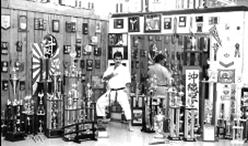 Residing and studying in Japan for many years, his field study took him to Korea, Taiwan, Southeast Asia, and China where he came into contact with many of the most senior authorities of various fighting arts31.
Residing and studying in Japan for many years, his field study took him to Korea, Taiwan, Southeast Asia, and China where he came into contact with many of the most senior authorities of various fighting arts31.
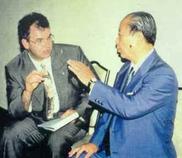
Such studies not only improved his skill and understanding but also resulted in the publication of several important literary contributions32 along with a brilliant thesis he called ” the Habitual Acts of Physical Violence (HAPV33) theory.” Having walked in the footsteps of those who pioneered modern karate, McCarthy’s progressive efforts were recognised34 in Japan. In fact, his teaching credentials come from the very same source, as did those of Funakoshi, Miyagi, Mabuni, Ohtsuka, Konishi, Sakagami, Yamaguchi, and Nagamine, to name a few of the most well-known luminaries35.
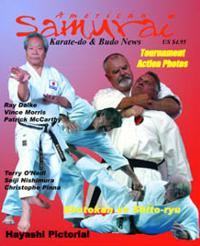 Systematizing the collective results of his field studies into a cohesive body of teaching practices, McCarthy Sensei has pioneered a new and highly functional interpretation of kata without losing any of its fundamental structure or cultural significance. A progressive traditionalist who believes that kata are the original time capsules of karate; his formula has attracted worldwide attention in a tradition normally dominated by large Japanese groups and their associated international sporting bodies.
Systematizing the collective results of his field studies into a cohesive body of teaching practices, McCarthy Sensei has pioneered a new and highly functional interpretation of kata without losing any of its fundamental structure or cultural significance. A progressive traditionalist who believes that kata are the original time capsules of karate; his formula has attracted worldwide attention in a tradition normally dominated by large Japanese groups and their associated international sporting bodies.
A recognized trailblazer in the application practices of traditional kata, McCarthy Hanshi has been invited to teach his theories in more than twenty countries around the world including Canada, the USA, Venezuela, Trinidad, Ireland, Scotland, England, Holland, Belgium, Germany, Austria, Norway, Sweden, Finland, Denmark, Russia, Israel, South Africa, Spain, Slovakia, Czech Republic, Estonia, Kenya, Japan, Australia, and New Zealand. The extent of his knowledge, quality of instruction, open-minded approach to teaching, and willingness to share, have all contributed to why this non-Japanese master-level instructor has become one of the most sought after teachers of traditional karate anywhere in the world today. When speaking about kata and application practices few instructors of traditional karate are better qualified to learn from than McCarthy Sensei.
Reverse Engineering
“We cannot solve our problems with the same level of thinking that created them.” (Albert Einstein)
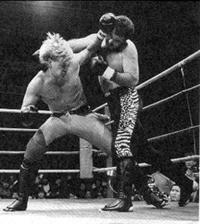 Both Okinawan and Japanese masters36 have maintained that kata is the soul of Karatedo, and yet, in spite of this ubiquitous testimony, its original defensive intentions remain ambiguous and convoluted37. Having made an art of extrapolation and reverse engineering38 McCarthy Hanshi has long employed these autodidactic techniques in conjunction with his HAPV-theory to discover how the underlying ideas and principles that govern application principles of kata work. In the book, “Karate Masters”, Nishiyama Hidetaka said, “Later on the student must connect the principle to the application. The old masters experienced these applications. Therefore, the practitioner has to study the outside form first, then understand the principle, and later connect the principle to the actual application39.” An exhaustive study of karate’s early historical and technical publications, comparative analysis of style-curricula, the disassembly of traditional kata and linking them to the HAPV40 have become the benchmark practices through which McCarthy Hanshi has effectively reconstructed the tactical concepts of kata. Ritualized model responses culminated in kata concern two principal issues, seizing and impacting, or combinations thereof. Excluding weapons41, being struck from behind42, and attacked by several opponents43, physical confrontation can be catalogued into individual and collective study/learning modules. Although there will always be variables unique to every encounter, the commonalities can be categorized into, physical techniques that have to do with seizing or impacting. Techniques of percussive impact include punching, kicking, elbowing, kneeing, striking, stomping, butting, and bumping. Seizing techniques include throwing, restraining, pressing, choking, wrestling, and the grabbing of an opponent to augment the effectiveness of impact trauma.
Both Okinawan and Japanese masters36 have maintained that kata is the soul of Karatedo, and yet, in spite of this ubiquitous testimony, its original defensive intentions remain ambiguous and convoluted37. Having made an art of extrapolation and reverse engineering38 McCarthy Hanshi has long employed these autodidactic techniques in conjunction with his HAPV-theory to discover how the underlying ideas and principles that govern application principles of kata work. In the book, “Karate Masters”, Nishiyama Hidetaka said, “Later on the student must connect the principle to the application. The old masters experienced these applications. Therefore, the practitioner has to study the outside form first, then understand the principle, and later connect the principle to the actual application39.” An exhaustive study of karate’s early historical and technical publications, comparative analysis of style-curricula, the disassembly of traditional kata and linking them to the HAPV40 have become the benchmark practices through which McCarthy Hanshi has effectively reconstructed the tactical concepts of kata. Ritualized model responses culminated in kata concern two principal issues, seizing and impacting, or combinations thereof. Excluding weapons41, being struck from behind42, and attacked by several opponents43, physical confrontation can be catalogued into individual and collective study/learning modules. Although there will always be variables unique to every encounter, the commonalities can be categorized into, physical techniques that have to do with seizing or impacting. Techniques of percussive impact include punching, kicking, elbowing, kneeing, striking, stomping, butting, and bumping. Seizing techniques include throwing, restraining, pressing, choking, wrestling, and the grabbing of an opponent to augment the effectiveness of impact trauma.
Patrick McCarthy’s far-reaching study has not only catalogued these obvious but all too often overlooked truths, he has also discovered their connection to kata and systematized them into simple learning modules. The informal presentation, below, outlines the substance and process of the seminars he teaches.

An Open Seminar
An open seminar is geared for introducing the historical research, theoretical concepts, and functional application practices as developed by McCarthy Hanshi. Ranging from a single evening, a day, or an entire weekend course, an open seminar is designed to benefit the multi-style traditional-based audience they usually attract and especially suites first-time participants, irrespective of style.
An open seminar usually consists of a lecture-style presentation on the history, philosophy and mechanical theory of karate, with special attention paid to kata. This is followed by the physical presentation of the theoretical concepts and includes a light warm-up consistent with the desired physical outcomes of the day’s training. Usually, a variety of two-person drills are taught, though the exact content is dependant upon the martial arts background of the participant (i.e. Shoto, Shito, Goju, Wado and Shorin etc.) and how much training time is available (3, 6 or 12 hours).During the longer weekend presentations, where more time is available, McCarthy Hanshi also details the origins, ethos & tactical strategies of modern Karate through its collective predecessors — Kata; The original Chinese form of human movement, Torite [Kyusho/Tuite]; Techniques of seizing and controlling, Tegumi; Okinawa’s original method of clinching & grappling, Tigwa; The plebeian form of percussive impact, & the influence of Zen, Japan’s shikata-based values and post-Edo/pre-war Japanese Budo Culture (i.e. Judo/Kendo & the Dai Nippon Butoku Kai). The nature of McCarthy’s two-person drills can be broken into two general categories. First are conditioning-type practices, such as the Tegumi44 & Muchimi-di45. These are sensitivity-based exercises geared to condition the body through controlled seizing and percussive-impact. The very nature of these drills open up a completely new and fascinating perspective of what is otherwise often described as mundane kihon-training. Second are the Kakushite-based46 kata application drills, which focus on pragmatic defensive practices, and help the participant better understand the relationship between the abstract composite techniques of kata and the corresponding HAPV-theory, to which they were originally developed to address.
McCarthy-related international publicity
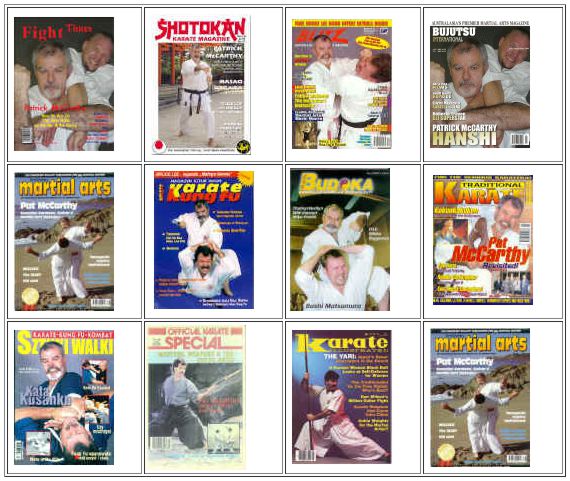
Having attended many of these training sessions, and having met many foreign seminar participants47, it’s not uncommon to hear how satisfied supporters are with this kind of training. It is even more reassuring to hear participants, especially those who have travelled hundreds of kilometres to learn these drills, express their willingness to return for more training, even though they may be from completely different styles48. In this field McCarthy Hanshi continues to set precedence. McCarthy Hanshi is not on a crusade to “improve” the world’s standard of karate training in his image, nor is he advocating that this training method is superior to anyone else’s or even that anyone will necessarily become a better fighter, warrior, competitive athlete or no-rules gladiator through his seminars. What he is doing, however, will most assuredly provide any participant49 with a better understanding of the traditional art of karate, and specifically the rationale behind classical kata application practices.
Pressure Points
 As presented in the Bubishi, the body of knowledge presented at this type of seminar was once a closely guarded secret of the ancient masters. It addresses those anatomically weak areas of the body susceptible to kinetic energy transfer based on the five principles:
As presented in the Bubishi, the body of knowledge presented at this type of seminar was once a closely guarded secret of the ancient masters. It addresses those anatomically weak areas of the body susceptible to kinetic energy transfer based on the five principles:
1. Location (The precise anatomical structure to be attacked)
2. Tool (Which part of the body [fist, foot, elbow, knee, fingertips, etc.] used to attack with)
3. Angle (The angle of energy transfer)
4. Direction (The direction of energy transfer; i.e. back to front, perpendicular to location, etc.)
5. Intensity (The amount of energy transfer necessary to achieve the desired outcome)
The detailed presentations in this kind of seminar will not only improve one’s fundamental knowledge of anatomical structures it will also deepen and widen one’s understanding of pain withdrawal reflex (PWR) and pre-determined response (PDR), two valuable components behind mechanical exploitation supporting kata rationale. This fundamental knowledge of anatomical structures, and their basic function, allows the karateka to better understand the rationale behind its tactical strategies, as set forth in kata. When speaking of Funakoshi Gichin’s training methods, Okazaki Teruyuki Sensei wrote, “As he was an academic and scientifically-minded person, he liked to explain how the human body worked and how important it was to use the right technique to the attack the right body parts.”50 This kind of seminar also addresses the medical implication of karate-related techniques and is an absolute must for all serious karateka seeking more than just a cursory understanding of the art.
Kuzushi, Nage & Ukemi-waza
 (Balance Displacement, Throwing, Tumbling & Falling/Landing)
(Balance Displacement, Throwing, Tumbling & Falling/Landing)
It seems axiomatic that you cannot learn the art of self-defence, especially a percussive-impact discipline like karate, without ever learning how to protect yourself from falling, being knocked down or even thrown to the ground. Unfortunately, ending up on the ground, irrespective of how unwelcome the thought may be, is something that is more than likely to happen in an actual physical confrontation. Ukemi-waza is the Japanese term that identifies those skills associated with learning to protect one’s self from the dangers associated with hitting the ground under such circumstances. As a prelude to learning how to displace one’s balance for the purpose of throwing, a seminar with McCarthy Sensei in these related skills begins with an introduction to ukemi-waza; a mandatory practice for any and all karateka. This kind of training is not only fun and highly informative, it adds a vital component to an otherwise ignored part of karate as an art. Confirming that throwing was, in fact, a part of old-school karate training, Okazaki Teruyuki wrote, “Funakoshi explained that many of the kata applications were throwing techniques. But he always stressed that before you throw your opponent to the floor you must punch or kick first in order to finish them”.51
Once a learner has grasped the basic ukemi-waza drills McCarthy Hanshi introduces the principles of Tsukamite,52 Chinkuchi,53 Nigirite,54 Kakete,55 Kuzushi,56 Hikite,57 and ashi/tai-sabaki 58 for the purpose of understanding the mechanics behind takedowns and throws. Collectively, these principles are paramount to learning about balance displacement. McCarthy Sensei has reversed engineered no fewer than 55 takedowns and throws from classical kata culminated in a wonderful two-person drill.
Katame-waza
(Lessons in Restraint/Immobilization)
Why Katame-waza have continued to set precedence over so many generations is because they are such an effective tool in controlling aggressive/violent behaviour. Just look at any military force, law-enforcement agency, private/professional and or diplomatic security as well as officers at correctional facilities; they are all schooled in the arts of restraint and immobilization. Why? Because it’s simply the easiest and most effective way with which to gain control without mortal injuring an opponent. Collectively, these practices are paramount to learning self-defence. McCarthy Hanshi has brought together hundreds of brutally effective practices from classical kata which he’s culminated in easy-to-learn two-person drills. As a rule there are three general classifications of restraint/immobilization:
1. Restraining/Immobilizing an opponent through air/blood deprivation.
2. Restraining/Immobilizing an opponent with joint manipulation and limb entanglement, enhanced by pressing cavities & seizing connective tissue.
3. Restraining/Immobilizing an opponent through ground control.
Shime-waza
(Strangulations-chokes/Sealing the Breath)
Perhaps one of the easiest to learn aspects of application practices is the art of rendering an opponent unconscious, through either sealing the air or restricting blood flow Learning how to choke an opponent to unconsciousness is a valuable skill in the overall art of self-defence and one that should not be ignored. Handed down via kata, shime-waza has, unfortunately, become a lost skill in the art of karate until recently revived through the efforts of McCarthy Sensei. Using assisted, unassisted and augmented chokes, McCarthy Hanshi has gleaned a massive 36 individual practices from his study of classical kata into a remarkable two-person drill called Shime-waza futari-geiko. Seminars in choking and strangulation draw upon his work in this area along its medical implications and related techniques of resuscitation.
Kansetsu/Tuite-jutsu
(Joint Manipulation, Seizing Connective Tissue & Cavity Pressing)
Learning how to twist bones, lock joints, seize weak parts of the human body and dig into those cavities unprotected by the skeletal structure has long been regarded as the inner-teachings of karate, limited only to the senior most disciples of any master. Not only are these practices brutally effective as tools of self-defense, they are, in fact, what separates those who know from those who do not!
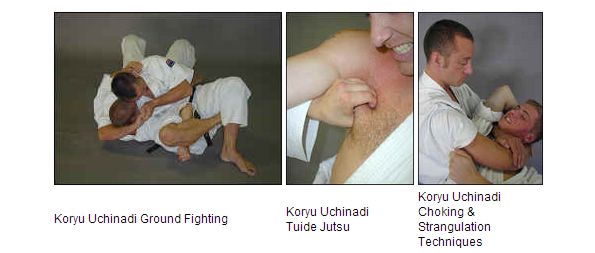
Applied Science:
Functional Anatomy & Physiology
A Kansetsu/Tuite-jutsu seminar taught by McCarthy Hanshi begins by introducing the knowledge and application of simple physics. Even though at first glance this may look unrelated, it is, nonetheless, an integral element of effective defensive application. With knowledge of our common anatomical structures, and knowledge of simple physics, it becomes possible to employ simple defensive concepts, based on simple machines59 to the limbs, neck and the torso, with brutal effectiveness. In order to effectively transfer kinetic energy to any given anatomical structure, during a defensive confrontation, McCarthy Hanshi also presents the fundamental concepts of biomechanics; specifically, the most efficient way of kinetic force for the expressed purpose of impeding motor function. McCarthy Sensei has brought together some 72 individual practices from classical kata, which are culminated in this remarkable two-person drill.

Ne/Osae-waza
(Grappling & finishing holds)
A seminar in this area explores the forgotten heritage of karate — the plethora of application practices that go beyond mere punching and kicking. When McCarthy Hanshi first introduced Tegumi-style drills during the early 1990’s, detractors promptly criticized him as having “fabricated” such wrestling practices60. However, after historical evidence of Tegumi (Okinawa’s plebeian form of grappling) was published in Nagamine Shoshin’s book, entitled “Tales of Okinawa’s Great Masters,” [a text translated into English by Patrick McCarthy] critics and cynics quickly retreated back to the safety of their keyboard-laden armchairs. Not surprisingly, many have now adopted the practice as their own. With the rise of the Gracie and Machado families, and the popularity of their Brazilian jujutsu methods, the karate world finally began to recognize the importance of what McCarthy Hanshi was openly criticized for teaching. McCarthy Hanshi has brought together 72 of the most important finishing holds into a single two-person drill.
The Bubishi
Lecture and hands-on instruction dealing with the single most important historical document of 19th and early 20th century Ryukyu Kenpo Karate-jutsu… “The Bible of Karate.”
Arguably, the Bubishi has had enormous impact on many of the pioneers of modern karate. Funakoshi Gichin (Shotokan) quoted the Bubishi extensively in several of his definitive publications. Referring to this historically important text as, “The Bible of Karate,” Miyagi Chojun (Goju Ryu) chose the name of his karate style from it. Mabuni Kenwa (Shito Ryu) actually published a version of it in 1934. A seminar on this historically important manual addresses its history, concepts, connection to TCM, and philosophy, with special attention paid to Happoren, Nepai, Rakkan-ken, Hakutsuru, the 29 Escape practices, & or the 48-posture practices. Few people in the world are better qualified to present the lessons outlined in this text than McCarthy Sensei who spent years researching its contents and published the very first and foremost English translation to the Western world.
More information and Bubishi book reviews located here;
Enter The Bubishi: Part 1- Introduction & Origins
Enter The Bubishi: Part 2- The Text & Its Impact On Okinawa
The Bible of Karate: Bubishi
International Ryukyu Karate Research Society Catalogue
Motobu Drills
A hands-on training opportunity to learn the pragmatic kumite practices of Motobu Choki (1870-1944), arguably the most formidable karateka ever to come out of Okinawa.
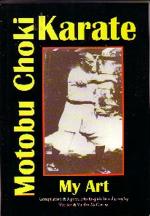 At a time when the entire traditional karate industry is searching for more functional kata-based application practices, a lone figure reappears from Okinawa’s past providing us all with more penetrating insights into this remarkable art. Learning his skills from the likes of Matsumora Kosaku (1829-1898), Bushi Matsumura (1809-1899), Itosu Ankoh (1830-1915), Tokumine Pechin (1850-1910), Motobu Choyu (1865-1929), Sakuma Pechin (DOB/D??), no one can deny the impeccable lineage Motobu Choki enjoyed. Perhaps no other pioneer influenced the diversity of this tradition, as had Motobu. Amidst his most notably students were Chibana Choshin (1885-1969, Shorin-Ryu), Konishi Yasuhiro (1893-1983, Shindo Jinen-Ryu), Nakamura Shigeru (1892-1969, Okinawan Kenpo), Ohtsuka Hironori (1892-1982, Wado-Ryu), Ueshima Sannosuke (1893-1986, Kushin-Ryu), Nakama Chozo (1899-1982, Shorin-Ryu), Yamada Tatsuo (1905-1967, Nihon Kenpo), Kokuba Kosei (c1905-1959, Motobu-ha Shitoryu), Nagamine Shoshin (1907-1997, Matsubayashi-Ryu), Shimabuku Tatsuo (1908-1975, Isshin-Ryu), Kaneshima Shinsuke (1896-DOD?, Tozan-Ryu), and Kaneshima Shinyei (1900-DOD?, Ishimine-Ryu).Having made the study of Motobu Choki, his history and teaching practices an in-depth undertaking, McCarthy Sensei’s efforts have brought him into personal contact with those who were either directly or indirectly connected with Motobu Choki, including Kuniba Shiyogo, Nagamine Shoshin, Miyahira Katsuya, Uehara Seikichi, Matsushita Kyocho, Konishi Takehiro, Kinjo Hiroshi, and Iwai Tsukuo.
At a time when the entire traditional karate industry is searching for more functional kata-based application practices, a lone figure reappears from Okinawa’s past providing us all with more penetrating insights into this remarkable art. Learning his skills from the likes of Matsumora Kosaku (1829-1898), Bushi Matsumura (1809-1899), Itosu Ankoh (1830-1915), Tokumine Pechin (1850-1910), Motobu Choyu (1865-1929), Sakuma Pechin (DOB/D??), no one can deny the impeccable lineage Motobu Choki enjoyed. Perhaps no other pioneer influenced the diversity of this tradition, as had Motobu. Amidst his most notably students were Chibana Choshin (1885-1969, Shorin-Ryu), Konishi Yasuhiro (1893-1983, Shindo Jinen-Ryu), Nakamura Shigeru (1892-1969, Okinawan Kenpo), Ohtsuka Hironori (1892-1982, Wado-Ryu), Ueshima Sannosuke (1893-1986, Kushin-Ryu), Nakama Chozo (1899-1982, Shorin-Ryu), Yamada Tatsuo (1905-1967, Nihon Kenpo), Kokuba Kosei (c1905-1959, Motobu-ha Shitoryu), Nagamine Shoshin (1907-1997, Matsubayashi-Ryu), Shimabuku Tatsuo (1908-1975, Isshin-Ryu), Kaneshima Shinsuke (1896-DOD?, Tozan-Ryu), and Kaneshima Shinyei (1900-DOD?, Ishimine-Ryu).Having made the study of Motobu Choki, his history and teaching practices an in-depth undertaking, McCarthy Sensei’s efforts have brought him into personal contact with those who were either directly or indirectly connected with Motobu Choki, including Kuniba Shiyogo, Nagamine Shoshin, Miyahira Katsuya, Uehara Seikichi, Matsushita Kyocho, Konishi Takehiro, Kinjo Hiroshi, and Iwai Tsukuo.
The Motobu publication review is located here:
In addition to bringing together most of the original articles, newspaper clippings, photographs, interviews and testimony ever published about him, McCarthy Sensei is also responsible for producing the only English translation of his 1932 publication entitled, “Watashi no Karate-jutsu”, as well as including a special section in that publication explaining the (Naihanchi/Bassai-based) kumite drills he published in 1926. Few people in the world are better qualified to present the lessons of this historically important pioneer…Patrick McCarthy Hanshi, is certainly one of them.
Junbi/Seri & Hojo Undo
A seminar on preparatory/cool-down exercises and training with classical supplementary equipment.
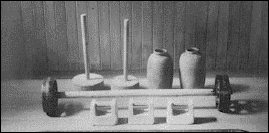 Probably one of the most neglected areas of traditional karate, proper warm-up and cool-down exercises are vitally important in preparing the body for optimum performance, protecting it against potential injury and restoring energy. The seminar taught by McCarthy Sensei in this area deals with a balanced program fusing together gentle joint motion movement, dynamic and static stretching, plyometrics and isokinetic tension (without Valsalva breath holding) practices. A well-balanced and structured warm-up and cool-down can make an important difference to any school’s curriculum. Hojo undo supplementary training exercises can and do improve any individual skill as well as having a noticeable influence on one’s strength, power and overall physical prowess. Pre-dating the development of modern weights and exercise equipment, these unique kigu (apparatuses) have been used for generations in Tanren (conditioning/forging), and are also an important window into the rich heritage and penetrating legacy of our tradition.
Probably one of the most neglected areas of traditional karate, proper warm-up and cool-down exercises are vitally important in preparing the body for optimum performance, protecting it against potential injury and restoring energy. The seminar taught by McCarthy Sensei in this area deals with a balanced program fusing together gentle joint motion movement, dynamic and static stretching, plyometrics and isokinetic tension (without Valsalva breath holding) practices. A well-balanced and structured warm-up and cool-down can make an important difference to any school’s curriculum. Hojo undo supplementary training exercises can and do improve any individual skill as well as having a noticeable influence on one’s strength, power and overall physical prowess. Pre-dating the development of modern weights and exercise equipment, these unique kigu (apparatuses) have been used for generations in Tanren (conditioning/forging), and are also an important window into the rich heritage and penetrating legacy of our tradition.
A seminar of this nature introduces the participant to the history and fundamental practices of Makiwara (impact post/board), Nigiri-game (gripping jars), Chi-ishi are (stone weights attached to a handle) including the Ishi/tetsu-sashi [stone/iron padlock] used like dumb bells, and Makiage (a wrist roller), Tan (resembling a barbell), Jari bako (vessel of small pebbles/beans), Ishi/tetsu-geta (stone/iron clogs), Tou (bamboo bundle, also referred to as také), Kongoken (a very heavy iron rectangular hoop introduced to karate training by Miyagi Chojun after his 1934 Hawaii visit), Tetsuarei (iron dumb bells) floor-to-ceiling ball, speed bag, heavy bags, medicine ball and focus mitts.
Having studied since childhood, McCarthy Sensei has brought together an impressive list of original and contemporary practices into completely systematized study certain to enhance any training curriculum.
Tegumi
(Two-person checking, trapping, & close-combat drills).
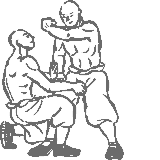 While classical Tegumi represents the plebeian-style grappling techniques of old-Okinawa, Hanshi McCarthy also saw fit to seek out, collect, study and include many of the two-person drills he had located in his research of various South East Asian combative traditions (including Silat, Arnis, and southern quanfa; i.e. Southern Praying Mantis, White Crane, Monk Fist & Wing Chun etc.). These practices help develop timing, awareness and sensitivity — especially at close range — using the hands, elbows, knees and head. From this, a unique collection of Kote-, Kashi-, and Tai-gitae/tanren (arm-, leg-, and body-conditioning), kakie (pushing hands), checking and trapping drills were systematized and included in his teaching curriculum. McCarthy Hanshi uses them to link fundamental technique to its corresponding defensive themes & application principles. One of the fastest growing practices; Tegumi blasts open the door to discovering kata application without adversely effecting the signature characteristics of one’s own style or system. McCarthy Sensei has brought together some 36 individual two-person drills from old-school karate, its southern quanfa progenitors, and SE Asian disciplines into a graduated system of learning.
While classical Tegumi represents the plebeian-style grappling techniques of old-Okinawa, Hanshi McCarthy also saw fit to seek out, collect, study and include many of the two-person drills he had located in his research of various South East Asian combative traditions (including Silat, Arnis, and southern quanfa; i.e. Southern Praying Mantis, White Crane, Monk Fist & Wing Chun etc.). These practices help develop timing, awareness and sensitivity — especially at close range — using the hands, elbows, knees and head. From this, a unique collection of Kote-, Kashi-, and Tai-gitae/tanren (arm-, leg-, and body-conditioning), kakie (pushing hands), checking and trapping drills were systematized and included in his teaching curriculum. McCarthy Hanshi uses them to link fundamental technique to its corresponding defensive themes & application principles. One of the fastest growing practices; Tegumi blasts open the door to discovering kata application without adversely effecting the signature characteristics of one’s own style or system. McCarthy Sensei has brought together some 36 individual two-person drills from old-school karate, its southern quanfa progenitors, and SE Asian disciplines into a graduated system of learning.
Muchimi-di
(Sticky-hand sensitivity drills)
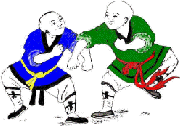 Until quite recently, most of the karate world had believed that such dynamic practices were limited to southern Chinese quanfa and had no connection to karate. However, the publication of the English language translation of the Bubishi has provided a wider audience with the evidence linking the origins of karate through Okinawa to Fujian quanfa. As a result, these sticky-hand and kosuri (arm rubbing) practices have become much more widely accepted. At the forefront of a movement to collect and study Muchimi-style drills, McCarthy Hanshi has successfully re-introduced many of these two-person practices he discovered in the years he spent in field research of the karate progenitor styles that can be found in Fujian.
Until quite recently, most of the karate world had believed that such dynamic practices were limited to southern Chinese quanfa and had no connection to karate. However, the publication of the English language translation of the Bubishi has provided a wider audience with the evidence linking the origins of karate through Okinawa to Fujian quanfa. As a result, these sticky-hand and kosuri (arm rubbing) practices have become much more widely accepted. At the forefront of a movement to collect and study Muchimi-style drills, McCarthy Hanshi has successfully re-introduced many of these two-person practices he discovered in the years he spent in field research of the karate progenitor styles that can be found in Fujian.
Based upon the concept of trapping an opponent’s hands/arms after an unsuccessful attempt of seizing or impacting a victim, Muchimi-di fosters the skill of controlling the attacker by continually pressing, trapping and or hooking. Several drills promote what is commonly referred to as heavy or sticky hands and rooted postures and are quite common in Fujian-based quanfa.
Kata
(Model Examples & Postures)
Probably one of the most common reasons behind the popularity of international seminars these days is the genuine desire to truly understand the nature and application of traditional kata. Most of McCarthy Sensei’s success over the years has been built up around his seminars on kata and their highly functional application practices. Once a closely guarded, secretive practice, kata is the very reason karate, as an art, has been preserved and passed down to this day. Its heritage can be traced back to the Chinese progenitors of quanfa. Sadly, the unique formula once used to help deliver the contextual intentions culminated in kata was lost in the wake of the modernization of Karate, which obscured the original defensive application principles. It can be argued that the North Asian, Confucian-based pedagogy is partially responsible for the widespread confusion in relation to kata. Specifically, a culture of learning and replicating “the classics”, rather than understanding them results in a gradual degradation of meaning. The result, when coupled with the cultural mystique surrounding the martial arts, has been a lack of recognition concerning the most logical scenarios addressed by kata. McCarthy Sensei approaches kata as classical configurations. Specifically, the kata seminar provides an entry point for negotiating HAPV through the classical forms contemporaneously practiced. Using contextual scenarios participants are able to rediscover the link between the ritualised movements of kata and their corresponding defensive principles, as originally intended, before exploring related henka.61
In addition, participants are introduced to a framework in which they are better able to understand how universal defensive principles were ritualised into model examples, and how these templates were ultimately configured into kata.
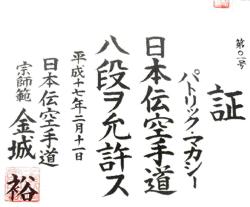 McCarthy Sensei frequently teaches application practices compatible with JKA-based kata and multi-style mainstream JKF traditions, such as Shito, Wado & Goju, etc. Specifically, Heian/Pinan, Tekki/Naihanchi, Hangetsu/Seisan, Bassai/Passai, Kanku/Kusanku, Nijushiho/Niseishi, Gangkaku/Chintou, Gojushiho/Ueseishi, Saifa, Sepai, Sanseryu, Shisoochin, Kururunfua, Suparinpei, and Tensho, etc. McCarthy Sensei has also spent years collecting, studying and teaching a plethora of unique and abstract kata, from older Okinawan traditions, and smaller family-based disciplines. Seventeen kata make up the principal curriculum he presents through Koryu Uchinadi. They include Chokyu (Gekkisai/Shinshi), Happoren (Paipuren), Kume Hakutsuru, Yara Kusanku, Naihanchi (Tekki), Nanshu, Nepai (Nipaipo), Aragaki Niseishi (Nijushiho), Matsumura Bassai, Rakan-ken, Ryushan, Miyagi Sanchin, Aragaki Seisan, Aragaki Sochin, Tai Sabaki (Koryu Uchinadi version), Aragaki Unshu and Wando (Wanduan).
McCarthy Sensei frequently teaches application practices compatible with JKA-based kata and multi-style mainstream JKF traditions, such as Shito, Wado & Goju, etc. Specifically, Heian/Pinan, Tekki/Naihanchi, Hangetsu/Seisan, Bassai/Passai, Kanku/Kusanku, Nijushiho/Niseishi, Gangkaku/Chintou, Gojushiho/Ueseishi, Saifa, Sepai, Sanseryu, Shisoochin, Kururunfua, Suparinpei, and Tensho, etc. McCarthy Sensei has also spent years collecting, studying and teaching a plethora of unique and abstract kata, from older Okinawan traditions, and smaller family-based disciplines. Seventeen kata make up the principal curriculum he presents through Koryu Uchinadi. They include Chokyu (Gekkisai/Shinshi), Happoren (Paipuren), Kume Hakutsuru, Yara Kusanku, Naihanchi (Tekki), Nanshu, Nepai (Nipaipo), Aragaki Niseishi (Nijushiho), Matsumura Bassai, Rakan-ken, Ryushan, Miyagi Sanchin, Aragaki Seisan, Aragaki Sochin, Tai Sabaki (Koryu Uchinadi version), Aragaki Unshu and Wando (Wanduan).
Perhaps William Dometrich, Chito Ryu 8th Dan and DNBK Hanshi, said it best, “Not only was I astonished by the depth of [McCarthy’s] knowledge of the historical roots of Karatedo, I was also pleasantly surprised by the incredible depth of [his] technical knowledge, skills and ability.” 62 In the words of Jundokan 8th Dan in Goju-Ryu, and American karate pioneer, Chuck Merriman, “History will remember McCarthy’s contributions simply because they’re too important to ignore.”
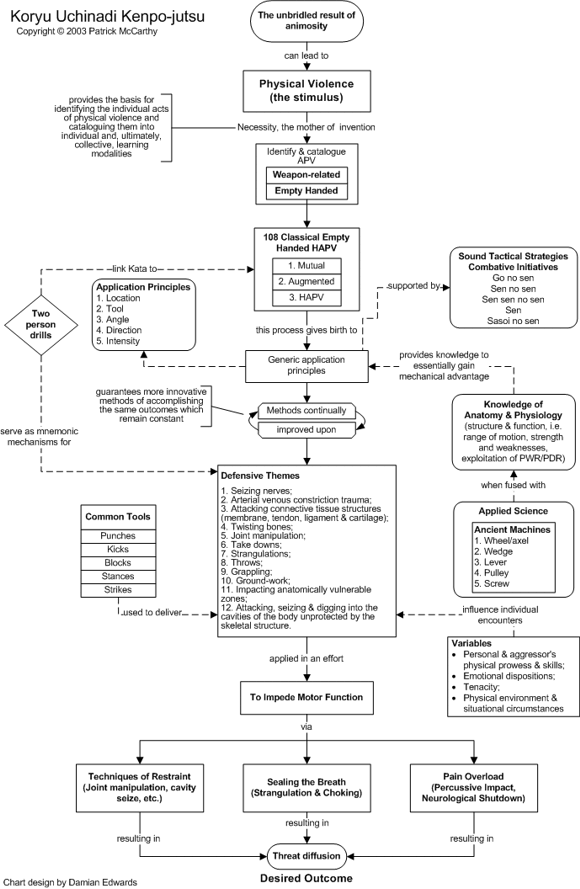
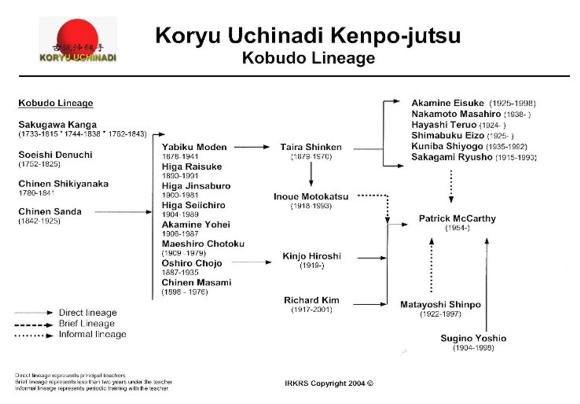
Kobudo
(The Weapon Art)
A kobudo seminar introduces the participant to the rare style of kobudo called Yamaneryu, as handed down to Kinjo Hiroshi Hanshi, through Grandmaster Oshiro Chojo (1887-1935)—one of the most noticeable disciples of its founder, Chinen Sanda (1842-1925)…see here.
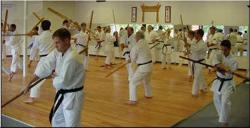 A long-time student of Richard Kim63 McCarthy Hanshi studied Yamane-ryu principles directly under KinjoHiroshi during the many years he resided in Japan. The core principles of his practice and curriculum have been significantly enriched with the fusion of McCarthy’s early experience in Chinese quanfa, the distinctive quality of Tenshin Shoden Katori Shinto Ryu, — as personally taught to him by the late Meijin, Sugino Yoshio (1904–1998) — and the brilliant innovations learned directly from Inoue Motokatsu Hanshi (1918-1993) Ryukyu Kobujutsu Hozon Shinkokai). As taught by McCarthy Sensei, this style brings together a variety of traditional Okinawan weapons (i.e. bo, eku, sai, nicho-gama, tonfa, tekko, tanbo, tenbi/rochin, nunchaku etc.) into a systematized and cohesive practice. This unique method removes the technical ambiguity often experienced in other methodologies and focuses on a completely application-based set of practices. A seminar with McCarthy Sensei, unless specifically addressing a classical kata, or supporting practices, is likely to focus on bo or sai-jutsu kata and drills: Fundamental postures, blocking, trapping & deflecting, swinging, grip changes, bo manipulation & body movement along with the fascinating two-person Pechin kumi-bo/sai drills based on the unique teachings of Sakugawa, Chinen Sanda, Tokumine and Inoue.
A long-time student of Richard Kim63 McCarthy Hanshi studied Yamane-ryu principles directly under KinjoHiroshi during the many years he resided in Japan. The core principles of his practice and curriculum have been significantly enriched with the fusion of McCarthy’s early experience in Chinese quanfa, the distinctive quality of Tenshin Shoden Katori Shinto Ryu, — as personally taught to him by the late Meijin, Sugino Yoshio (1904–1998) — and the brilliant innovations learned directly from Inoue Motokatsu Hanshi (1918-1993) Ryukyu Kobujutsu Hozon Shinkokai). As taught by McCarthy Sensei, this style brings together a variety of traditional Okinawan weapons (i.e. bo, eku, sai, nicho-gama, tonfa, tekko, tanbo, tenbi/rochin, nunchaku etc.) into a systematized and cohesive practice. This unique method removes the technical ambiguity often experienced in other methodologies and focuses on a completely application-based set of practices. A seminar with McCarthy Sensei, unless specifically addressing a classical kata, or supporting practices, is likely to focus on bo or sai-jutsu kata and drills: Fundamental postures, blocking, trapping & deflecting, swinging, grip changes, bo manipulation & body movement along with the fascinating two-person Pechin kumi-bo/sai drills based on the unique teachings of Sakugawa, Chinen Sanda, Tokumine and Inoue.
The Lost Art
McCarthy Sensei postulates that the original intention set forth by the early pioneers of our tradition was to have learners study the HAPV so that they were able to understand how tactical strategies and application practices were developed and employed. The birth of commercial martial arts schools64 provided a safe environment in which HAPV could be systematically recreated and tactical strategies methodically re-enacted in two-person drills65. Such efforts were repeated with gradual or exponential degrees of intensity, depending entirely on the individual aptitude of each learner, until a functional spontaneity unfolded and the learner developed the competency to effectively use the application principles irrespective of the HAPV. Through this embryonic process early professional teachers first recognized the benefit of ritualising the solo re-enactment of these defensive practices into individual model responses.66 “Kata used to mean, “symbol,” and was written in the same way. The physical movement was just a vehicle to understand and identify the internal principle.” 67 Intended as mnemonic mechanisms, model responses helped innovators remember and organize the plethora of tactical strategies they developed. When martial arts schools became a popular trend in China, quanfa68 instructors depended heavily upon these model responses as principal tools of instruction. Linking together myriad model responses allowed learners to express varying degrees of skill while improving physical, mental, and holistic conditioning, hence strengthening the overall learning process. In an effort to establish and standardize core curricula in these early schools, pioneers formalized unique model responses into creative geometrical shapes69. In this phenomenon we find the cradle, which gave birth to kata. However, kata were never originally developed to impart the actual lesson, but rather to culminate what had already been taught. This changed radically when attention shifted from the classical one-on-one, or, small group hands-on style instruction, to drilling huge groups of students in the schoolyards of turn-of-the-century Okinawa. Training curricula were simplified and kata became the principal tool used for fostering physical fitness and social conformity in Okinawa’s school system.
Opposition & Politics
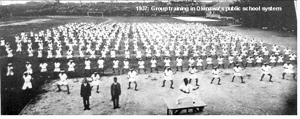 “There is nothing more difficult, more perilous to conduct, or more uncertain in it’s success, than to take the lead in the introduction of a new order of things. Because the innovator has for enemies all those who have done well under the old conditions, and lukewarm (indifferent, uninterested) defenders, in those who may do well under the new.”70
“There is nothing more difficult, more perilous to conduct, or more uncertain in it’s success, than to take the lead in the introduction of a new order of things. Because the innovator has for enemies all those who have done well under the old conditions, and lukewarm (indifferent, uninterested) defenders, in those who may do well under the new.”70
As is often the case, opposition inevitably rears its ugly head whenever orthodoxy is challenged and there are those within the karate community who find McCarthy Sensei’s conclusions less than appealing. Let us not forget that “Contempt prior to full investigation enslaves a person to ignorance”. Dr. John Ray. Unfortunately it can be argued that an overprotective mindset is more the rule in this industry than it is the exception. That said, it is important to be reminded that “truth is not determined by majority vote”,71 “nor does it change merely because of lack of understanding, disbelief or ignorance”.72 A tradition whose origins and function are complicated by myth and mysticism, modern karate has outwardly become dominated by a politicized, narrow mindset, all too often disguised as a way to preserve the “purity” of a particular style when in truth, it is about ego, power/control and money.
Such animosity has done nothing to promote a deeper understanding of the art, and has instead only bred hypocrisy, fragmentation and isolation. Considering that critical thinking and eclecticism was the principal tool that long served those who pioneered this tradition, so too should it come as no surprise that McCarthy Sensei has become so empowered by thinking outside the box. Independent researchers, writers and journalists, and the ever-popular web-author “authority”, all can and do influence the history and understanding of this wholly unregulated tradition & industry. On the one hand, such diverse reporting and personal opinion provokes fascinating perspectives. On the other hand, however, uncorroborated historical testimony, misunderstanding, naivety, and hidden agenda, makes so much of it suspect. It is ironic that the critics and cynics of McCarthy Sensei have been unable to provide any counter evidence to support their claims of heresy, suggesting that their objections to his conclusions are more based around issues of faith and dogma than they are based on historical evidence. Beyond baseless innuendo, no such evidence has ever surfaced and yet those who could make the biggest difference continue to shun his brilliant contributions. Perhaps McCarthy Sensei’s work is a testament to the Schopenhauerian dialectic whereby, “All truth passes through three stages: First, it is ridiculed. Second, it is violently opposed. Third, it is accepted as being self-evident.” To this end, McCarthy Sensei encourages learners to think outside the box and discover the truth for themselves.
Conclusion
McCarthy Sensei reminds each of us that kata is better understood through studying the sum total of its individual parts. Perhaps it is for this reason that his popularity is sustaining such longevity in a tradition where other very competent instructors continually come and go. By all accounts his growing popularity seems to be fuelled by four things:
#1. A genuine desire to better understand the true nature of the art.
#2. The quality of what he is imparting.
#3. His student-friendly teaching style.
#4. A sincere appreciation for his willingness to openly share the penetrating insights and his practices. Moreover, his open-minded approach to teaching, supported by the friendly and informal atmosphere he cultivates with his charismatic personality, makes attending his seminars not just a rewarding learning experience, but also a genuine pleasure.
Built upon timeless principles, Karate is a way to condition the body, cultivate the mind & nurture the spirit. Through diligent training one can improve health, its holistic purpose; be better prepared to protect oneself, its defensive application; build moral character, its social aim; discover and overcome the source human weakness, its philosophical nature, and finally, to know inner-peace, its spiritual essence. Supporting every facet of this practice is a message far greater than the physical conduit through which it is delivered. The art reminds each of us of our own humanity, the importance of improving the quality of daily life and our responsibility to contribute to the welfare of those within the field of our influence. Respecting time honoured values, Hanshi Patrick McCarthy is a dedicated professional promoting both this timeless message and functional application practices with a new generation of more progressive learner seeking to better understand traditional Okinawan/Japanese karate and not afraid to look outside their own peer groups to find it. Echoing the wisdom of Funakoshi Gichin,73 “All traditional karate is one —Karatedo. Traditional karate is Budo. We MUST keep this philosophy.”74 I hope this presentation has offered you an alternative look into the fascinating art of kata. If so, and you want to learn more about becoming part of this groundbreaking movement or even hosting a seminar at your dojo, I invite you to contact the International Ryukyu Karate Research Society c/o admin@koryu-uchinadi.com
In the words of Krishnamurti, “All of us are working together in a spirit of real co-operation in which there is no single authority: it is our interest in the teachings which brings us together and helps us to work together.” Genuine inquiries are always warmly welcomed.
“Only now that I am walking down the path of Koryu Uchinadi am I realizing the depths of the gifts that this Karate has to offer. Had I chosen not to follow this path I would have never known what I had missed, yet having chosen this path I am now receiving the rewards that all karate practitioners deserve.” Richard Ouellette, Canada
Endnotes
#1 Lit. Okinawa-hand (i.e. Okinawa-te) Popularized in the last decade, the local Okinawan term means karate.
#2 The editor of Japan’s first karate magazine (1957; Gekkan Karatedo) Kinjo Hiroshi (1919). A published author and highly regarded historian in Japan’s traditional karate community and a 4th generation master of Uchinadi who studied directly under Hanashiro Chomo, Tokuda Anbun and Gusukuma Shimpan. Master Kinjo also studied Yamane-ryu kobudo directly under Oshiro Chojo, the principal disciple of Chinen Sanda (1882-1942)
#3 Hanashiro Chomo authored the first book on karate in 1905 entitled, “Karate Kumite” in which he used the ideogram to express karate as an empty-handed art; something Funakoshi Gichin is mistakenly accredited with. Kinjo Hiroshi also learned under Oshiro Chojo, Gusukuma Shinpan, Yabu Kentsu and Tokuda Anbun.
#4 Regarded as the grandfather of modern karate, it was Itosu Ankoh (1837-1915) who simplified Okinawa’s 19th century quanfa practices and introduced them into the public school system for the purpose of fostering physical fitness and moral conformity. He is best remembered for his Oct 1908 document entitled, “Ten Items.”
#5 Having studied quanfa in Fujian-China, swordsmanship in Satsuma-Japan, Bushi Matsumura Sokon (1809-1899) is regarded as the principal pioneer of the martial arts movement in and around the old castle capitol of Shuri.
#6 By the time he retired in the mid-1980’s, Patrick McCarthy had won more than two-hundred open championships in forms, weapons and fighting and was a nationally rated competitor.
#7 Amongst McCarthy’s several publications is the Bubishi, one of Charles E. Tuttle’s best selling martial arts titles
.#8 When asked who stood out as some of the most impressive karate men he’d ever met, fifty year veteran and pioneer of karate in America, William Dometrich, wrote, “As far as historians go, I’d have to say that Patrick McCarthy — he’s simply unbelievable.” Karate Masters by Jose M. Fraguas Unique publications 2001, p84
#9 Uchina-go (Hogan dialect): An old local term referring to the local eclectic-based empty-handed fighting art which evolved from Siamese boxing. (Return to Top of Page)
#10 Okinawa’s interest in percussive-impact fighting with the fists and feet comes from an early appreciation of Siamese boxing (early Muay Thai) popularized throughout SE Asia during the 18th & 19th centuries; Tegumi reflects an ancient and local heritage of wrestling/grappling; Qin Na [Torite] represents the art of seizing and controlling popular amongst local law enforcement, private security, royal body guards, and prison guards; The Hsing/kata of Fujian-Chinese quanfa (Toudi-kenpo).
#11 Itosu Ankoh pioneered a simplified version of quanfa that was introduced into Okinawa’s turn-of-the-century public school system as an adjunct to the athletics curriculum. Itosu Ankoh publicly declared the physical, moral and social ramifications of karate, in 1908, when he wrote to the Ministry of Education and the Department of War: “Karate does not only endeavor to discipline one’s body, if and when the necessity occurs to fight for just cause karate provides the fortitude in which to risk ones own life in support of that campaign.” (1908; paragraph
1). The primary purpose of karate training is to strengthen one’s physique so that one can use the hands and feet like weapons. Karate cultivates bravery and valor in children and it should be encouraged in our elementary schools. Don’t forget what the Duke of Wellington said after defeating Emperor Napoleon: “Today’s victory was first achieved from the discipline attained on the play-grounds of our elementary schools.” (Ibid; paragraph
2) After just three or four years of unremitting effort one’s body will undergo a great transformation revealing the very essence of karate. (Ibid; paragraph
3) Because karate training strengthens muscle and bone, improves the digestive organs and regulates blood circulation karateka usually enjoy a long and healthy life. Therefore, if karate were introduced into schools and practiced extensively we could more easily produce immeasurable defense capabilities. (Ibid; paragraph 10) Itosu Ankoh concluded that if, and when, karate was disseminated throughout the entire nation, not only would it benefit people in general but also be an enormous asset to our military forces.
#12 In many ways karate is miniature representation of the unique culture in which it unfolded. Reflecting ancient Confucian-based rituals, inflexible social and political ideology, and profound spiritual conviction, karate was profoundly influenced by Meiji Kokutai no Hongi; Based on the Kojiki & Nihon Shoki (“Ancient Chronicles of Japan”) National Polity represented absolute obedience to the Emperor, prevention of democracy, individualism, and freedom of rights. It was revised by the Monbusho (Ministry of Education) and republished in 1937. Shushin; Educational expectation (est. 1880), Shushin was a principal subject demanding loyalty to the Emperor, obedience to one’s parents, lifelong dedication to the company. Nihonjinron: Theory of Japanese uniqueness as a race.
#13 Karate, as first taught by Funakoshi Gichin on the mainland, was limited to kata.
#14 Karate was first demonstrated on the mainland of Japan in 1917 (Kyoto Butokuden demonstration by Funakoshi Gichin & Matayoshi Shinko), and later introduced and taught by Motobu Choki in 1921, by Funakoshi Gichin in 1922, Miyagi Chojun & Mabuni Kenwa in 1928 and finally ratified as a Japanese budo in December of 1933. These years fell in the very midst of Japan’s era of miniaturization and there is one theory that karate was popularized to support Japan’s war machine.
#15 Largely through the efforts of Konishi Yasuhiro (1893-1983) karate was introduced to the ultra conservative Dai Nippon Butoku Kai through its Judo department where it was compelled to conform to nationally recognized Japanese budo standards before being ratified as an official martial art;
1.) Eliminate the (kara/Tou) prefix reflecting its Chinese origins and replace it with a term “kara,” which would better identify its physical application.
2.) Replace the antiquated term “jutsu”, which emphasized its combative application, with the “do/michi” suffix personifying its national and holistic outcomes.
3.) Eliminate the informal training apparel and officially adopt the standard judo-like practice uniform.
4.) Eliminate the Chinese sash worn around the waist and officially adopt the judo-like obi (belt).
5.) Officially adopt the dan/kyu pedagogy.
6.) Establish a competitive practice in order to test both the physical prowess and fighting spirit of those who study the tradition.
#16 Karate first became a popular practice amongst students at schools like Takashoku, Meiji, Keio and Waseda University.
#17 Ju-jutsu, Judo, Karate, Aikido and Kendo etc.
#18 Mr. McCarthy first took up karate in 1968 at age 13 under instructor Adrian Gomes in Saint John (New Brunswick), Canada.
#19 Before undertaking his studies with Kinjo Hiroshi in Japan, McCarthy Sensei studied karate under Masami Tsuruoka in 1970/71 (Toronto), Dave Chong in 1972/73 (London), Dan Pai in 1973 (Hartford), Wally Slocki from 1974-1977 (Toronto), and finally Richard Kim, of the Zen Bei Butokukai from 1977-1987.
#20 “Clapping your hands together above your head can cause your assailant to launch a sudden and uncoordinated kicking attack.” Nakayama Masatoshi, Best Karate series, (Unsu, Sochin and Nijushiho) p140. Ohtsuka Hironori wrote, “Naihanchi has three katas, Shodan, Ni-dan and San-dan, but the last two are almost useless.” Wado Ryu Karate,” English translation by Masters Publication, Ontario 1997, page 72.
#21 When speaking about early teaching standards, Nishiyama Hidetaka’ s most senior foreign student, Ray Dalke, wrote, “I started teaching almost right away. What I learned the class before I would teach in the next class I taught.” Karate Masters by Jose M. Fraguas Unique publications 2001, p34.
#22 Okazaki Teruyuki sensei wrote, “If I used the same teaching methods I did forty years ago, I wouldn’t have any students today”. Karate Masters by Jose M. Fraguas Unique publications 2001, p 291.
#23 Rule-bound practices based on kihon, kata & kumite with little or no relationship to the habitual acts of physical violence (HAPV).
#24 Overly ritualized and highly impractical attack scenarios plague modern karate instruction. In many cases the opponent is required to wait motionless after the reverse-punch is thrown while the defender carries out the counterattack!
#25 When speaking about kata, Wado Ryu karate teacher, Mr. Sakai told Mike Clarke, “I think he (Ohtsuka Hironori) thought that Kumite was more important than kata. Also, even in the old days, some teachers did not know why some actions were done in a Kata.” ‘Recollections of the Founder’ – an interview with Sakai Sensei, 8th Dan, Wado Ryu by Australasian Fighting Arts magazine columnist Mr. Mike Clarke. Australasian Fighting Arts Vol 18 No.4 (1996) pp 57-58.
#26 Having studied for fifty years, highly regarded Shotokan master, Okazaki Teruyuki sensei, wrote in The Textbook of Modern Karate, “many of the kata techniques are not useful except in terms of exercise.” Speaking about who knew what about kata, during the late forties, Nishiyama Hidetaka, in an interview published in Fighting Arts International (FAI #51), recalled that many of the seniors had forgotten their kata and often had to get together to pool their knowledge.
#27 Nakayama Masatoshi wrote in Best Karate Volume 5, p106, “Since these (naihanchi) kata are rather monotonous, turn the head briskly and strongly.”
#28 Punching and kicking are only two of the myriad of techniques that comprise the practice; Other techniques are for checking, trapping, and various alternative kinds of impacting, along with seizing, throwing, choking and joint manipulation, etc.
#29 In response to how the other 5 kata of Uechi Ryu were developed, Master Tomoyose told an enthusiastic crowd, “Following WWII they (Okinawans) were all so poor that it was often a struggle to find the money necessary to feed their families. One of the things they could do was hold karate demonstrations and charge spectators an entrance fee. Problem was, they could only do 3 kata, some breaking, some sparring and they’d be done … the spectators were miffed because they felt that they had not gotten their money’s worth. So Kanei Uechi, R. Tomoyose and their contemporaries got together to develop additional kata so their demos would be longer and people would be willing to pay money to see it! ” Posted by Bruce Hirabayashi to the Uechi-Ryu.com discussion forum here.
#30 Ray Dalke Sensei wrote, “Sensei Nishiyama rarely ever taught bunkai – in fact, I can’t remember when he did teach it.” Karate Masters by Jose M. Fraguas Unique publications 2001, p43
#31 The most recognizable Japanese/Okinawan instructors are Sakagami Ryusho, Kuniba Shiyogo, Inoue Motokatsu, Matayoshi Shinpo, Nagamine Shoshin, Miyazato Eiichi, Uechi Kanei (Uechi-ryu), Uechi Kanyei (Shito-ryu Kenpo), Higa Yuchoku, Higa Seikichi, Akamine Eisuke, Yagi Meitoku, Uehara Seikichi, Konishi Takehiro, Kinjo Hiroshi, Nakazato Joen, Nishihira Kosei, Tokashiki Iken, Murakami Katsumi, Kanzaki Shigekazu, Hisataka Masayuki, Shimabuku Eizo, Hokama Tetsuhiro, Nakamoto Masahiro, Matsushita Kyocho, Prof. Shinzato Katsuhiko and his teacher Kishaba Sensei and more.
#32 Mr. McCarthy’s publications include the “Bubishi”, Motobu Choki’s “My Karate”, Funakoshi Gichin’s “Tanpenshu”, “The Ancient Okinawan Martial Arts“ (Koryu Uchinadi) in two volumes, Nagamine Shoshin’s “Tales of Okinawa’s Great Masters”, Classical Kata of Okinawan Karate”, and a plethora of historical articles, technical papers and interviews and a series of educational video tapes.
#33 An acronym representing the Habitual Acts of Physical Violence, the HAPV-theory provides a contextual premise for how and why the composite technique of kata works. By identifying and cataloguing each HAPV into individual and ultimately collective learning modalities learners are provided with an opportunity of recreating each act of physical violence in a safe learning environment for the purpose of understanding the rationale behind those classical tactical strategies used in traditional kata. By removing the attacker in each of the two-person drills and then ritualizing the solo-re-enactment into a mnemonic-like template we discover the common element used in kata. When the “professional” martial arts school was born these templates were shaped into various geometrical configurations to establish teaching curriculum’s culminating the defensive lessons already learned.
#34 In addition to being a lineage-based student of Kinjo Hiroshi, and ranked 8th dan [8段], McCarthy received his Renshi license (1988), and Kyoshi license (1994) from the Kyoto-based Dai Nippon Butoku Kai, and his Hanshi license from the World Kobudo Federation (2004).
#35 Funakoshi Gichin (Shotokan), Miyagi Chojun (Goju Ryu), Mabuni Kenwa (Shito Ryu), Ohtsuka Hironori (Wado Ryu), Konishi Yasuhiro (Shindo Jinen Ryu/Ryobukai), Sakagami Ryusho (Itosu-ha Shito Ryu), Yamaguchi Gogen (Goju Kai), and Nagamine Shoshin (Matsubayashi Ryu), were amongst the most notable karate recipients of Dai Nippon Butoku Kai recognition.
#36 Pioneers such as Funakoshi, Mabuni and Miyagi, etc. have echoed this sentiment. “Kata is karate. All techniques are taken from kata. Let me put it this way: if you look at the history of karate, all the old masters developed certain kata based on their perception of combat. Original kata is very valuable.” Karate Masters by Jose M. Fraguas Unique publications 200, p280.
#37 Kata is the symbol of karate so it never changes. Unfortunately, 95 percent of the people don’t understand kata – only the outside movements which are irrelevant without understanding. Each kata evolved out of the experience of the masters. Through it, they embody the principles of karate. Karate Masters by Jose M. Fraguas Unique publications 2001, p 283.
#38 Reverse Engineering is the art of analyzing what makes a product work. It means dismantling the whole to understand the parts. Reverse Engineering involves informed dissecting, testing, comparing and analyzing, as well as detailed documentation. With no historical documentation concerning the underlying mechanisms of kata presently available, and no qualified authorities to explain it, extrapolation and reverse engineering are two of the most pragmatic techniques employed and promoted by McCarthy Sensei.
#39 “Karate Masters”, by Jose M. Fraguas Unique publications 2001, p280.
#40 Using the governing rules of simplicity and brutality, McCarthy Sensei worked backwards from the habitual acts of physical violence to arrive at pragmatic defensive application practices before contrasting them with existing model responses ritualized in existing traditional kata.
#41 Karate is an empty-handed tradition, which was originally developed as a civil defensive mechanism to be used against an empty-handed attacker; It was never developed to be used by warriors on the “battlefield” or by professional athletes in the arena.
#42 How can anyone defend himself or herself against something they cannot see?
#43 McCarthy Sensei concluded that the tactical strategies culminated in kata were developed to be used primarily in a one-on-one empty-handed attack scenario divided into three categories,
1. Mutual confrontation,
2. The clinch, and
3. HAPV: i.e. headlock, bear hug, lapel grab, full nelson, etc.
#44 Originally a plebeian form of grappling popular during Okinawa’s old Ryukyu Kingdom, McCarthy sensei assigned this defunct name to a collection of two-person trapping, checking and conditioning drills he’s brought together from a variety of sources in 1992.
#45 Muchimidi (moo chi me dee) is an Okinawan term describing the sticky or heavy hand conditioning drills used in old-style karate.
#46 From the verb “kakusu” to hide or conceal (“te” = hand) Kakushi-te is a term commonly used to describe that which cannot be readily seen; i.e. kakushi-tsuki, a hidden punch, and, those “hidden” aspects of kata, such as the distractions that are not shown but (should be) taken for granted.
#47 It’s remarkable to know just how many of McCarthy Sensei’s students are actually foreign-based seminar participants who’ve followed him to Australia to study under him.
#48 The standing myth maintains that a seminar participant can only reap benefit from those lessons imparted by an instructor of the same style. Reducing kata to its application practices based on the habitual acts of physical violence, Patrick McCarthy rationally destroys this fallacy, which allows every participant to discover the true secrets of kata.
#49 McCarthy Sensei has received a drawer full of accolades from instructors all around the world; notables also include Wally Jay, Richard Kim, Ed Parker, Chuck Merriman, Terry O’Neill, Harry Cook, William Dometrich, Vince Morris, Joe Swift, Dr. Milorad Stricevic and more. Testimonials
#50 “Karate Masters”, by Jose M. Fraguas Unique publications 2001, p 285/86.
#51 “Karate Masters” by Jose M. Fraguas Unique publications 2001, p 292/93.
#52 Tsukamite refers to grasping the body or a limb for the purpose of avoiding a strike, and displacing balance, before using the opponent’s power against him thus enhancing the effectiveness of defensive action. P48 English translation of Karate-jutsu by Kodansha International.
#53 The total summation of joint forces, combined with the breath to maximize one’s technique.
#54 Refers to grasping and shaking and opponent.
#55 Refers to hooking an opponent with your grip.
#56 Refers to breaking the balance of one’s opponent.
#57 Refers to the technique of pulling (a wrist, arm, someone’s garment) and twisting it in order to create an anatomical weakness with which to physically exploit. The twisting of one’s hand back to the hip, for example, in kata, is symbolic of this technique.
#58 Two terms referring to footwork and body movement.
#59 The wedge, common levers, the screw, pulley and wheel/axel.
#60 Amidst the first wave of foreign shoot-fighters in Japan, McCarthy Sensei fought as a shoot-boxer and also worked with the UWFI in 1989-93 as a trainer/sparring partner with grapplers like Takada Nobuhiko, Tamura Kiyoshi, Gary Albright, and Billy Scott, etc.
#61 Variations: i.e. the same technique can have varying applications depending upon the context of violence being responded to.
#62 Testimonials
#63 Richard Kim Hanshi (1917-2001) was one of Hawaii’s leading Karate pioneers, particularly in the area of research and journalism. In 1927, at the tender age of 8, the young Kim watched a Karate demonstration at the Nuuanu YMCA by Yabu Kentsu, who was visiting Hawaii on his way back to Okinawa. A few years later in 1933, he met Mizuho Mutsu, who was visiting Hawaii from Tokyo with Higaonna Kamesuke. As an adult, Kim worked for the President’s Shipping Line, which enabled him to travel and learn Karate and other arts in the orient, including kobudo. He became one of the very first foreign members of the Dai Nippon Butokukai, then the leading martial arts organization in Japan, and went on to establish branches in North America and France. He was often referred to as the “Harvard Professor” of Karate, was well known for his study of rare kata and unique brand of kobudo.
#64 Villages/towns in 19th century China often hired quanfa experts for domestic security and training local residents. Also, traveling herb hawkers and quanfa performers were said to teach for money. Tracing its lineage to Hung Ga quanfa, one of the earliest schools was established by Luk Achoi around 1770-1800. This trend became far more popular towards the end of the Qing Dynasty (1644-1911). Of course, one of the most famous was the Chin Woo/Jing Mo established in 1909 by Huo Yan Jia (1867 – 1909) in Shanghai.
#65 The purpose of the two-person drill was so that each act of physical violence could be recreated with varying degrees of intensity, while the other person re-enacted the defensive template until competency was established.
#66 This is the Chinese ideogram for model, which is pronounced hsing (kata in Japanese) and, in the case of karate, serves to illustrate an example.
#67 As described by Nishiyama Hidetaka in “Karate Masters” by Jose M. Fraguas Unique publications 2001, p280
#68 Kenpo in Japanese.
#69 This is the Chinese ideogram for the word shape and is pronounced hsing (kata in Japanese) and refers to a configuration.
#70 Quote by Nicolo Machiavelli 1469-1527
#71 Quote by Doug Gwyn.
#72 Quote by W. Clement Stone.
#73 Quoting Funakoshi, Okazaki Teruyuki sensei wrote, “The basics are the same because we are all human beings.” Karate Masters by Jose M. Fraguas Unique publications 2001, p 291.
#74 Quote by Nishiyama Hidetaka; Karate Masters by Jose M. Fraguas Unique publications 2001, p 283.

